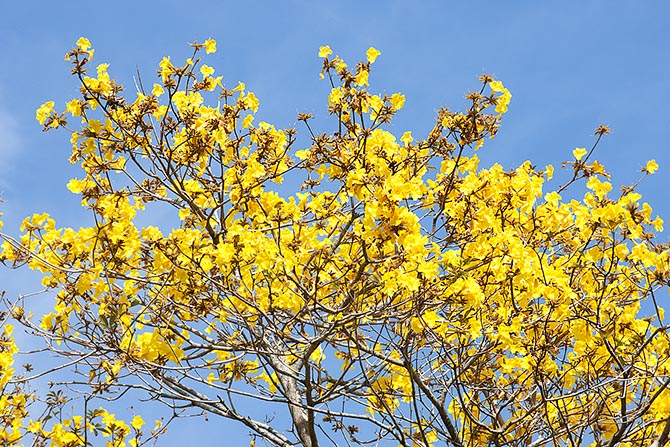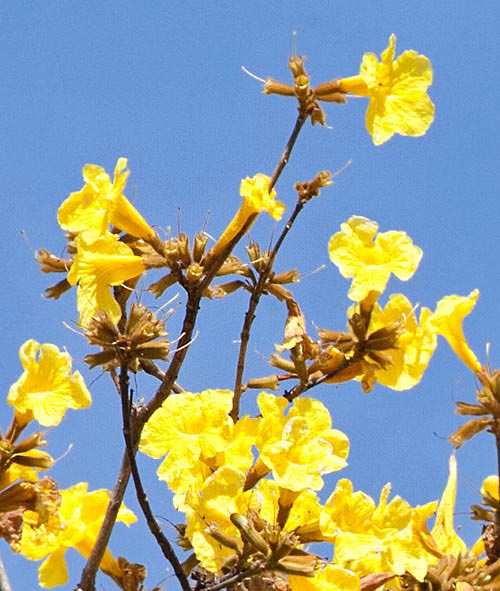Family : Bignoniaceae

Text © Pietro Puccio

English translation by Mario Beltramini

The Handroanthus chrysotrichus is the national flower of Brazil © Giuseppe Mazza
The species is native to eastern and southern Brazil and north-eastern Argentina, where it grows in the Atlantic pluvial forest.
The name of the genus is the combination of the name of the Brazilian botanist Oswaldo Handro (1908-1986) and of the Greek term “anthos” = flower; the name of the species is the combination of the Greek terms “chrusos” = gold, yellow and “trichos”, genitive of “thrix”= hair, with reference to the hirsute calyx.
Common names: golden trumpet tree, yellow trumpet tree (English); ipê jaune (French); aipé, ipê, ipê-amarelo, ipê-amarelo-cascudo, ipê-amarelo-paulista, ipê-do-morro, ipê-tabaco, pau-d’arco-amarelo (Portuguese Brazil); árbol amarillo, guayacán, lapacho, lapacho amarillo, tajibo (Spanish).
Handroanthus chrysotrichus (Mart. ex DC.) Mattos (1970) is an evergreen, but often deciduous for a short time in spring, tree, 4 to 10 m tall with diameter of the trunk of 30-40 cm, with fissured bark of brown colour and young branches and petioles covered by thick rust-coloured hair.
The leaves, on a long petiole, are opposite, palmate-compound, usually with 5 obovate leaflets with pointed apex and wavy margin, entire on the lower half, serrate in the upper one, of 3-10 cm of length and 1,5-6 cm of breadth, pubescent, in particular in the lower page, dark green up, pale green below; the leaves fall for a short time at the time of the flowering. The racemose terminal inflorescences, 10-20 cm long, carry numerous funnelform flowers with 5 lobes having wavy margins, 7-10 cm long and of 5-8 cm of diameter, of golden yellow colour, rich of nectar.

It has terminal inflorescences with 7-10 cm funnel-shaped flowers © Giuseppe Mazza
The fruits are dehiscent (which spontaneously open when ripe), cylindrical, hairy, capsules of pale brown colour, 15-30 cm long and of about 1,5 cm of diameter, containing a crowd of flattened and winged seeds, 2,8 cm long and 0,7 cm broad, dispersed by the wind.
It usually reproduces by seed which germinates in 1-2 weeks in sandy organic soil kept humid at the temperature of 22-24 °C, with fast initial growth, as it can exceed the 3 m by the second year of age, in the best cultivation conditions, and flowering starting from the third year; it reproduces also by semi-woody cutting in spring and by air layering.
Species diffused in the tropical and subtropical countries due to its spectacular flowering as isolated specimen in parks and gardens, even small, and in particular as road tree, seen its fairly contained dimensions, its cultivation may be tried, marginally, in the warm temperate climate zones, where adult plants can stand for short time temperatures up to about -4 °C. In order to get a best growth it requires an exposition in full sun and is not particular about the soil, provided it is draining, well rooted plants can stand periods of dry, in particular by the end of winter, which foster a more copious flowering.
The wood is very resistant and lasting and is utilized in the civil and naval constructions for works intended for outdoor; from it they get also a pigment utilized in the colouring of silk and cotton.
The tree is considered the floral symbol of Brazil.
Synonyms: Tecoma chrysotricha Mart. ex DC. (1845); Tecoma flavescens Mart. ex DC. (1845); Tecoma obtusata DC. (1845); Gelseminum chrysotrichum (Mart. ex DC.) Kuntze (1898); Tecoma grandis Kraenzl. (1921); Tabebuia chrysotricha (Mart. ex DC.) Standl. (1936).
